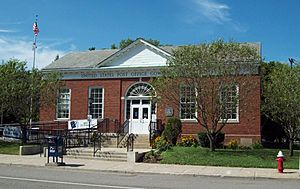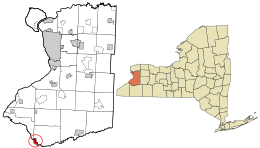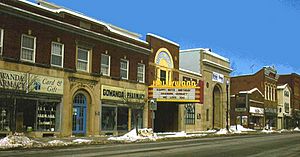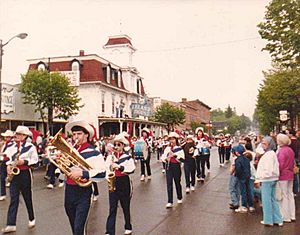Gowanda, New York facts for kids
Quick facts for kids
Gowanda
|
|
|---|---|
| Village of Gowanda | |

U.S. Post Office, Gowanda, NY, August 2010
|
|

Location in Erie County, New York.
|
|
| Country | United States |
| State | New York |
| Counties | Cattaraugus, Erie |
| Towns | Persia, Collins |
| Area | |
| • Total | 1.61 sq mi (4.17 km2) |
| • Land | 1.59 sq mi (4.13 km2) |
| • Water | 0.02 sq mi (0.04 km2) |
| Elevation | 761 ft (232 m) |
| Population
(2020)
|
|
| • Total | 2,513 |
| • Density | 1,577.53/sq mi (609.09/km2) |
| Time zone | UTC-5 (Eastern (EST)) |
| • Summer (DST) | UTC-4 (EDT) |
| ZIP code |
14070
|
| Area code(s) | 716 |
| FIPS code | 36-29630 |
| GNIS feature ID | 0951430 |
Gowanda is a small village in western New York, United States. It is special because it sits in two different counties: Erie County and Cattaraugus County. In 2020, about 2,513 people lived there.
The name "Gowanda" comes from a local Seneca language term. It means "almost surrounded by hills" or "a valley among the hills." The part of Gowanda in Erie County is near the big city of Buffalo. The part in Cattaraugus County is closer to Olean.
Gowanda is partly in the Town of Collins (Erie County) and partly in the Town of Persia (Cattaraugus County). The Cattaraugus Reservation is right next to Gowanda. Many Seneca people live there.
Gowanda Airport (D59) is a small airport with a grass runway. It is used for general aviation. East of Gowanda, you can find Zoar Valley along Cattaraugus Creek. It has over 2,000 acres (8.1 km2) of wild nature, hiking paths, and beautiful waterfalls.
Contents
Gowanda's Location and Landscape
Gowanda is located at 42°27′48″N 78°56′11″W. The village covers about 1.6 square miles (4.2 km2). A small part of this area, about 0.02 square miles (0.04 km2), is water.
Cattaraugus Creek flows right through the village. This creek also marks the border between Erie and Cattaraugus counties. So, the northern part of Gowanda is in Erie County, and the southern part is in Cattaraugus County.
Major roads like U.S. Route 62, NY Route 39, and NY Route 438 pass through Gowanda. The New York and Lake Erie Railroad has a station here. It carries goods and sometimes offers passenger rides.
People of Gowanda
| Historical population | |||
|---|---|---|---|
| Census | Pop. | %± | |
| 1870 | 994 | — | |
| 1880 | 1,243 | 25.1% | |
| 1900 | 2,143 | — | |
| 1910 | 2,012 | −6.1% | |
| 1920 | 2,673 | 32.9% | |
| 1930 | 3,042 | 13.8% | |
| 1940 | 3,156 | 3.7% | |
| 1950 | 3,289 | 4.2% | |
| 1960 | 3,352 | 1.9% | |
| 1970 | 3,110 | −7.2% | |
| 1980 | 2,713 | −12.8% | |
| 1990 | 2,901 | 6.9% | |
| 2000 | 2,842 | −2.0% | |
| 2010 | 2,709 | −4.7% | |
| 2020 | 2,513 | −7.2% | |
| 2023 (est.) | 2,456 | −9.3% | |
| U.S. Decennial Census | |||
In 2000, there were 2,842 people living in Gowanda. The village had 1,161 households. About 27.4% of these households had children under 18. The average age of people in Gowanda was 41 years old.
Gowanda's Past: A Look Back
Early People and Settlements
Long ago, during the Stone Age, nomadic Algonquian peoples lived in this area. An ancient mound, about 3,500 years old, was found near Gowanda. It contained old tools and spearheads. Later, in the 1300s, the Iroquois people came to live along Cattaraugus Creek. They were known as strong and proud people.
After the Revolutionary War, the U.S. government made land agreements with the Iroquois. In 1797, a company bought most of the land, except for ten American Indian reservations. The Cattaraugus Reservation was one of these protected areas. Many early settlers in Gowanda were Quakers from Vermont.
How Gowanda Grew
The village was settled in 1810. It was first called "Aldrich's Mills." Turner Aldrich and his Quaker family were the first European settlers. They traveled from Connecticut and bought a large piece of land. Aldrich built a sawmill and a gristmill (for grinding grain). Farmers would travel from far away to use his gristmill.
Later, the village was called "Lodi." But this caused confusion with another Lodi in New York. So, the name was changed to "Gowanda." This name came from the local American Indian term Juc-Gowanda, meaning "a valley among the hills." The village officially became Gowanda in 1848.
Gowanda in the 1800s
Fires caused a lot of damage in Gowanda during the 1800s. A big fire in 1856 destroyed most of the village in Erie County. Another fire in 1875 burned many businesses.
Many men from Gowanda, both European Americans and American Indians, fought in the Civil War. They joined New York regiments.
Gowanda was also a secret stop on the Underground Railroad. This was a network of safe houses and routes that helped enslaved people escape to freedom. An underground tunnel, still existing today, connected a train drop-off area to a safe house. This house helped former slaves escape to Canada around the 1860s.
The Thomas Asylum for Orphan and Destitute Indian Children was built nearby in 1855. It was also known as the "Thomas Indian School." This school housed and educated orphaned American Indian children for many decades.
In 1894, a large state hospital was built near Gowanda. It was called the Homeopathic State Hospital. This hospital later became the "Gowanda Psychiatric Center." Today, these buildings are used as correctional facilities.
Industries of the 1900s
In the 1900s, two important industries in Gowanda were tanning (making leather) and glue production. The first tannery started in 1829. These factories were very important for the village's economy.
The Peter Cooper Corporation Glue Factory in Gowanda became "the largest glue making plant in the world." Because of this, Gowanda was known as America's glue capital.
Gowanda Today: Recent Events
Fun Events and Entertainment
Gowanda hosts the Hollywood Happening every June. This event celebrates the historic Hollywood Theatre. Main Street is closed off for motorcycles and live music. Many local bands play rock, country, and blues music. There are also food and merchandise vendors. In 2008, about 22,000 people attended the Hollywood Happening.
Every fall, Gowanda holds the Harvest Heritage Festival. People can take tours of historic gardens. There's also a scarecrow contest where local businesses compete. The scarecrows are then displayed around town for Halloween.
Gowanda also offers free tours of Pine Hill Cemetery in October. These tours include actors dressed in old costumes who tell stories about the people buried there.
Parts of the 1987 comedy movie Planes, Trains and Automobiles, starring Steve Martin and John Candy, were filmed in Gowanda. You can see the Gowanda Train Depot and the Olympia Diner in the movie.
Floods and Community Changes
Gowanda has experienced serious floods. In 2009, a flood badly damaged the Tri-County Memorial Hospital. It had to be torn down. Later, an urgent care facility was opened in Gowanda instead of rebuilding the hospital.
Another flood happened in May 2014. Cattaraugus Creek and Thatcher Brook overflowed. This caused a state of emergency. The flood damaged Gowanda's water reservoir, and residents had to save water. Many homes were flooded with water and mud.
Famous People from Gowanda
- Albertus W. Catlin – A US general.
- John Elliot – A songwriter.
- Daniel Garnsey – A former US congressman.
- Joseph Giglio – A New York state assemblyman.
- Gregory Lamberson – A film director and novelist.
- Bill Paxon – A former US congressman.
- Jared Sidney Torrance – The founder of Torrance, California.
Places to Visit and Explore
- Chang Hu Park – A park honoring Drs. Chang and Hu, who helped plan and build the town.
- McIntosh Woods – Woods between Collins and Gowanda, named for wild apple trees.
- Creekside Park – A historic park along Cattaraugus Creek in the center of Gowanda.
- Zoar Valley – A beautiful valley formed by Cattaraugus Creek, great for nature lovers.
Correctional Facilities
North of the village are two medium-security prisons: the Gowanda Correctional Facility (opened in 1994) and the Collins Correctional Facility (opened in 1982). These facilities used to be the Gowanda Psychiatric Center.
Schools in Gowanda
The Gowanda Central School System is a public school system. It includes Gowanda Central High and Middle Schools, Gowanda Elementary School, and Aldrich Street (primary) School. The high school is just outside the village.
Gowanda Christian Academy is another school in the village. Saint Joseph's School, a Roman Catholic school, operated in the village until it closed in 2014.
Images for kids
See also
 In Spanish: Gowanda para niños
In Spanish: Gowanda para niños






